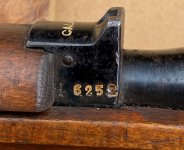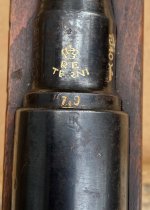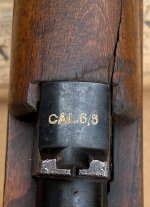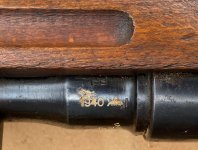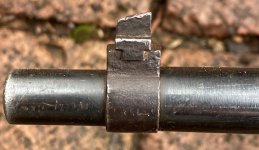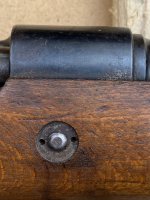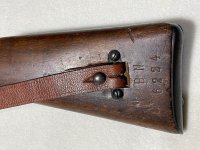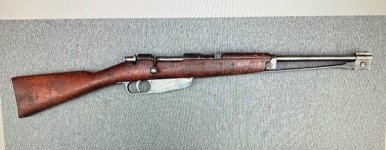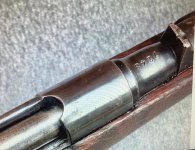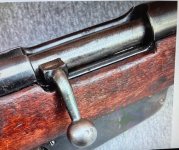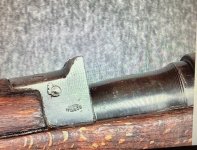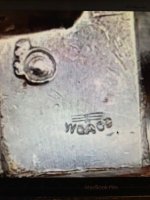I criticized Ian for his HK pistol video, so I think it is only fair to give him credit for his German Carcano video. Its pretty good, and it gives me an excuse to talk about these at some length which is something I have been meaning to do.
I do have a few corrections and additions to what he says. Caveat: This is based largely on what Wolfgang Riepe allegedly dug out of the Bundesarchiv, but its all second hand info. I have not seen the actual documents.
Volkssturm?
I am not 100% sure these were originally intended for the Volkssturm. The Volkssturm was a party organization, and while the Army handed out some stuff to them, they were usually given a grab bag of junk, mostly captured weapons handed over by the Army, privately owned shotguns and hunting rifles, and even rifles bought by their local Gauleiters on the black market in Italy. It didn't really matter what type and caliber they were using since they were local defense militia and not front line combat units. I also find it odd that Volkssturm weapons would be sent to the Infanterieschule for testing by well trained professional soldiers. Did they do that with other Volksgewehr rifles? Was the Army even involved with those emergency Primitiv-Waffen projects at all?
I think these may have been intended for issue to front line combat units, at least originally. There was a very severe shortage of rifles in 1945. The Wehrmacht apparently went so far as to take back all of the K98k that had been given to Volkssturm units in late 1944.
Krieghoff
Krieghoff was certainly the primary firm doing this conversion work, though it isn't exactly clear where they did it. An Italian article mentions that a Krieghoff facility in Eichsfeld (that may or may not have existed) was ordered to do the work on 22 December 1944 by the Reichsminister für Rüstung und Kriegsproduktion, but one of the documents Riepe transcribed from the office of Der Chef der Heeresrustung und Oberbefehlshaber des Ersatzheeres (Chief of Army Armaments and the Supreme Commander of the Replacement Army) dated 8 January 1945 mentions modification by "Fa. Krieghoff, Werk Glashütte, Gabelgrund/Thüringia" which doesn't make much since Glashütte is no where near Thüringia. Not sure if this a document error, an error of Riepe's transcription, or if I am misunderstanding something. If any of our German or Austrian friends can make sense of this, let me know.
Production was originally estimated to start at 500/day and very optimistically targeted an increase to 1000/day. They were not entirely delusional though and only expected 5000 in January due to start up difficulties. The big problem seemed to be rifling machines. They could not get enough to increase production and to do so would require a reduction in machines available for K98k, K43, and Sturmgewehr production which they were absolutely not going to do. It is claimed the Heereswaffenamt delivery document from March shows a total production of only 3100 in January 1945.
General characteristics are a H or K prefix, German K98k recoil lug, and stock serial number under the receiver on the side. Bolts will be etched with the SN, and the stocks will usually be depot marked. New, taller front sights were installed and rear sight ladders (when present) were removed. Finally the first 30,000-40,000 or so were planned to be single shot until magazine production came online, which was achieved by simply installing a wooden block in the magazine well. Note that there is an early variation that lacks the lug and prefix, and the stock serial number is by the Italian number instead of one the side. In general, they did not over stamp the 6.5 like the one Ian shows. I’m not sure that is original. The 7 looks modern.
Heeresgruppe C and Waffenamt/Dienststelle Italien
It is less well known that a second operation was also working on these. Heeresgruppe C in Italy and Waffenamt/Dienststelle Italien had come up with their own design, presumably being worked on by FNA-Brescia in Northern Italy. It is also mentioned that three plants in total had been ordered to produce 5000 per day. Another fantasy, but it seems at least some were made. One HGr C carbine was delivered to Doberitz for testing, and it is alleged that 4500 were made in Brescia in February (out of a total delivery of 12,320). What exactly these looked like is anybody's guess, but we do know they were repeaters that used modified Italian enbloc clips.
One possibility that at least some of the post-war 8mm Carcanos are in fact German supervised construction, but that is only speculation. None of these show any German markings, but the factories were still nominally under Italian control. 1944/45 Beretta pistols and very late Armaguerra M41 were both produced under German supervision and show no German markings at all. There is one mention in the Infantrieschule documents that these were new production (Neufertigung) and not modifications (umgebaut or umänderung). However, this may simply be a document error which are not uncommon. The Italian guns in other places are referred to as modified (umänderung) and the one gun that was sent to Döberitz by HGr C seems to have been a conversion since the barrel date (1941/XIX) was accidentally recorded as the serial number.
Repeaters and Infanterieschule Döberitz
So despite what Ian says, there were in fact magazine fed Carcanos produced. It is true that Krieghoff apparently did not expect to begin full production of repeaters until May, but in late January, Infanterieschule Döberitz received 5 repeating rifles for testing. 4 M41 were delivered from Krieghoff that used a Mauser style magazine and standard K98k stripper clips, and 1 M38 Short Rifle delivered by Herresgruppe C from Brescia (presumably FNA?) that used the original Carcano magazine and modified Carcano enbloc clips. The Krieghoff M41s had some accuracy and sight issues, but the magazine system worked well. The Brescia gun, not so much. Accuracy was very poor, the Mannlicher magazine system was disliked, and the modified Italian clips were very unreliable. There is no mention of recoil lugs at all, at least in what I have.
Ultimately, while the M41s modified with a Mauser magazine were found to be more or less acceptable as a second line weapon, the Infanterieschule recommended against issuing these rifles to any combat troops or Volkssturm, and only recommended them for guard troops (Wacheinheiten). The Infanterieschule also recommended against continuing with the Heeresgruppe C short rifle conversions at all, and that the M41 simply be issued in their original 6.5 caliber where possible. They did not fully reject the Krieghoff M41 conversions though and requested 50 more of the “improved” models for continued testing.
Ferlach
Finally, we have the Ferlach guns. There are a very few of these floating around, all commercially proofed by the Ferlach proofhouse and dated March 1945. Apparently, according the Ferlach, 225 guns were proof tested in March. They were clearly intended to be used as repeaters since the receiver has been notched for the longer 7.92mm cartridge. Who converted these and for what purpose is unknown. I would guess the work was done by a Ferlach gunsmith for the local party. 200 rifles would probably be enough for a VS battalion.
Summing Up
According to the alleged HWaA report from 1 March 1945, 3,100 conversions were delivered by HK in January and a total of 12,320 were delivered in Feburary, 4,500 of which were purported to be Italian. That leaves a total 7829 for HK in February. Added up that comes to a grand total of 10,920 in the first two months of 1945 by HK. I have no idea if any were made in March and April, but I would assume at least some were.
Known approximate HK serial ranges and types:
1-5000? Initial or preproduction run? No H/K prefix, no recoil lugs, stock serial number on the side by the buttplate, all M41
H1-H5999, Unknown? M41 H2747 is the only known survivor
H6000-H7000, M38 Short Rifles
H7000-H8000, M41
H8000-H9000. presumably M38 Cav Carbines, only one or two reported apparently and all very late in the range
H9000-H9999, K1-K1100, M38 Cav Carbines
The one rifle known between H1-H6000, H2747, looks legit IMO. It is basically a barreled action only, and it shows the characteristics of the later prefix guns and does not fit in with any of the first type HK rifles. If it is legit, I think its safe to assume HK restarted the serial numbers at some point in February for some reason. It would also mean around 16,000 were completed by HK, and we would only need to assume another 5K in production in March/April which I think is very reasonable.
With the Heeresgruppe C guns, I can only speculate that the guns were either never actually produced in any numbers or were later reworked by the Italians and sold off to various Arab countries. I don’t think 4500 guns (at least) would simply disappear, and I have always found it odd they would convert Carcanos to 8mm just to pawn them off on the third world.
I do have a few corrections and additions to what he says. Caveat: This is based largely on what Wolfgang Riepe allegedly dug out of the Bundesarchiv, but its all second hand info. I have not seen the actual documents.
Volkssturm?
I am not 100% sure these were originally intended for the Volkssturm. The Volkssturm was a party organization, and while the Army handed out some stuff to them, they were usually given a grab bag of junk, mostly captured weapons handed over by the Army, privately owned shotguns and hunting rifles, and even rifles bought by their local Gauleiters on the black market in Italy. It didn't really matter what type and caliber they were using since they were local defense militia and not front line combat units. I also find it odd that Volkssturm weapons would be sent to the Infanterieschule for testing by well trained professional soldiers. Did they do that with other Volksgewehr rifles? Was the Army even involved with those emergency Primitiv-Waffen projects at all?
I think these may have been intended for issue to front line combat units, at least originally. There was a very severe shortage of rifles in 1945. The Wehrmacht apparently went so far as to take back all of the K98k that had been given to Volkssturm units in late 1944.
Krieghoff
Krieghoff was certainly the primary firm doing this conversion work, though it isn't exactly clear where they did it. An Italian article mentions that a Krieghoff facility in Eichsfeld (that may or may not have existed) was ordered to do the work on 22 December 1944 by the Reichsminister für Rüstung und Kriegsproduktion, but one of the documents Riepe transcribed from the office of Der Chef der Heeresrustung und Oberbefehlshaber des Ersatzheeres (Chief of Army Armaments and the Supreme Commander of the Replacement Army) dated 8 January 1945 mentions modification by "Fa. Krieghoff, Werk Glashütte, Gabelgrund/Thüringia" which doesn't make much since Glashütte is no where near Thüringia. Not sure if this a document error, an error of Riepe's transcription, or if I am misunderstanding something. If any of our German or Austrian friends can make sense of this, let me know.
Production was originally estimated to start at 500/day and very optimistically targeted an increase to 1000/day. They were not entirely delusional though and only expected 5000 in January due to start up difficulties. The big problem seemed to be rifling machines. They could not get enough to increase production and to do so would require a reduction in machines available for K98k, K43, and Sturmgewehr production which they were absolutely not going to do. It is claimed the Heereswaffenamt delivery document from March shows a total production of only 3100 in January 1945.
General characteristics are a H or K prefix, German K98k recoil lug, and stock serial number under the receiver on the side. Bolts will be etched with the SN, and the stocks will usually be depot marked. New, taller front sights were installed and rear sight ladders (when present) were removed. Finally the first 30,000-40,000 or so were planned to be single shot until magazine production came online, which was achieved by simply installing a wooden block in the magazine well. Note that there is an early variation that lacks the lug and prefix, and the stock serial number is by the Italian number instead of one the side. In general, they did not over stamp the 6.5 like the one Ian shows. I’m not sure that is original. The 7 looks modern.
Heeresgruppe C and Waffenamt/Dienststelle Italien
It is less well known that a second operation was also working on these. Heeresgruppe C in Italy and Waffenamt/Dienststelle Italien had come up with their own design, presumably being worked on by FNA-Brescia in Northern Italy. It is also mentioned that three plants in total had been ordered to produce 5000 per day. Another fantasy, but it seems at least some were made. One HGr C carbine was delivered to Doberitz for testing, and it is alleged that 4500 were made in Brescia in February (out of a total delivery of 12,320). What exactly these looked like is anybody's guess, but we do know they were repeaters that used modified Italian enbloc clips.
One possibility that at least some of the post-war 8mm Carcanos are in fact German supervised construction, but that is only speculation. None of these show any German markings, but the factories were still nominally under Italian control. 1944/45 Beretta pistols and very late Armaguerra M41 were both produced under German supervision and show no German markings at all. There is one mention in the Infantrieschule documents that these were new production (Neufertigung) and not modifications (umgebaut or umänderung). However, this may simply be a document error which are not uncommon. The Italian guns in other places are referred to as modified (umänderung) and the one gun that was sent to Döberitz by HGr C seems to have been a conversion since the barrel date (1941/XIX) was accidentally recorded as the serial number.
Repeaters and Infanterieschule Döberitz
So despite what Ian says, there were in fact magazine fed Carcanos produced. It is true that Krieghoff apparently did not expect to begin full production of repeaters until May, but in late January, Infanterieschule Döberitz received 5 repeating rifles for testing. 4 M41 were delivered from Krieghoff that used a Mauser style magazine and standard K98k stripper clips, and 1 M38 Short Rifle delivered by Herresgruppe C from Brescia (presumably FNA?) that used the original Carcano magazine and modified Carcano enbloc clips. The Krieghoff M41s had some accuracy and sight issues, but the magazine system worked well. The Brescia gun, not so much. Accuracy was very poor, the Mannlicher magazine system was disliked, and the modified Italian clips were very unreliable. There is no mention of recoil lugs at all, at least in what I have.
Ultimately, while the M41s modified with a Mauser magazine were found to be more or less acceptable as a second line weapon, the Infanterieschule recommended against issuing these rifles to any combat troops or Volkssturm, and only recommended them for guard troops (Wacheinheiten). The Infanterieschule also recommended against continuing with the Heeresgruppe C short rifle conversions at all, and that the M41 simply be issued in their original 6.5 caliber where possible. They did not fully reject the Krieghoff M41 conversions though and requested 50 more of the “improved” models for continued testing.
Ferlach
Finally, we have the Ferlach guns. There are a very few of these floating around, all commercially proofed by the Ferlach proofhouse and dated March 1945. Apparently, according the Ferlach, 225 guns were proof tested in March. They were clearly intended to be used as repeaters since the receiver has been notched for the longer 7.92mm cartridge. Who converted these and for what purpose is unknown. I would guess the work was done by a Ferlach gunsmith for the local party. 200 rifles would probably be enough for a VS battalion.
Summing Up
According to the alleged HWaA report from 1 March 1945, 3,100 conversions were delivered by HK in January and a total of 12,320 were delivered in Feburary, 4,500 of which were purported to be Italian. That leaves a total 7829 for HK in February. Added up that comes to a grand total of 10,920 in the first two months of 1945 by HK. I have no idea if any were made in March and April, but I would assume at least some were.
Known approximate HK serial ranges and types:
1-5000? Initial or preproduction run? No H/K prefix, no recoil lugs, stock serial number on the side by the buttplate, all M41
H1-H5999, Unknown? M41 H2747 is the only known survivor
H6000-H7000, M38 Short Rifles
H7000-H8000, M41
H8000-H9000. presumably M38 Cav Carbines, only one or two reported apparently and all very late in the range
H9000-H9999, K1-K1100, M38 Cav Carbines
The one rifle known between H1-H6000, H2747, looks legit IMO. It is basically a barreled action only, and it shows the characteristics of the later prefix guns and does not fit in with any of the first type HK rifles. If it is legit, I think its safe to assume HK restarted the serial numbers at some point in February for some reason. It would also mean around 16,000 were completed by HK, and we would only need to assume another 5K in production in March/April which I think is very reasonable.
With the Heeresgruppe C guns, I can only speculate that the guns were either never actually produced in any numbers or were later reworked by the Italians and sold off to various Arab countries. I don’t think 4500 guns (at least) would simply disappear, and I have always found it odd they would convert Carcanos to 8mm just to pawn them off on the third world.

















